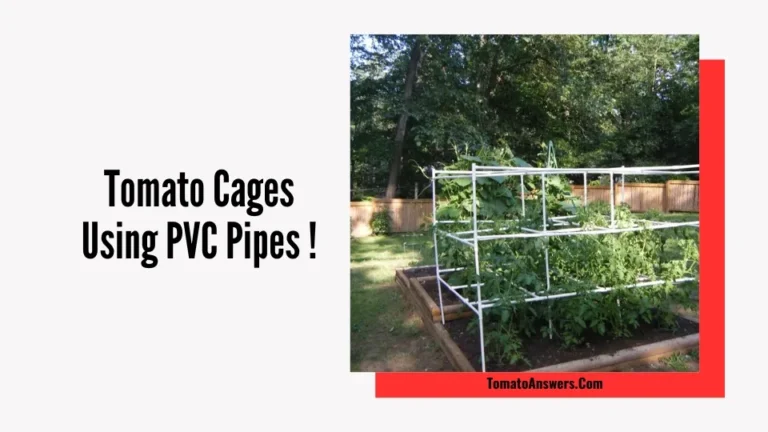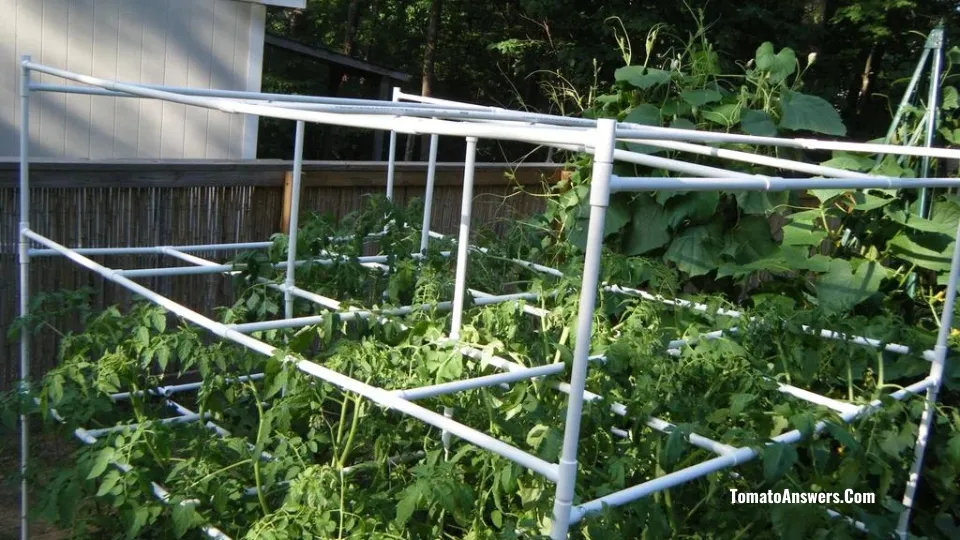Growing big, beautiful tomatoes starts with providing proper support immediately. While flimsy wire tomato cages from the store tend to bend and collapse, building your sturdy tomato cages from PVC pipe is easy and affordable. With just a few basic supplies and tools, you can create customized cages that will withstand weather and heavy fruiting for seasons to come.
In this guide, you’ll learn:
- The benefits of using PVC pipe for tomato cages
- Step-by-step instructions for constructing cages from PVC
- Tips for installing and using your homemade PVC tomato cages
Let’s explore why PVC makes an ideal trellising material for tomato plants and how you can easily DIY super-strong cages for your garden.
In This Article
Why Choose PVC Pipe for Tomato Cages?
Here are some of the top advantages of using PVC pipe over wire cages:
- Durability: PVC is thick, sturdy, responsive to weather and repeated use. It won’t bend, sag, or collapse like thin wire.
- Custom sizing: Cages can be crafted taller or wider based on needed support.
- Reusable: PVC cages can be used season after season for years of growing.
- Low maintenance: PVC won’t rust and is easy to clean between seasons.
- Lower cost: Buying basic PVC parts is more affordable than purchasing commercial cages.
- Easy assembly: PVC pipes and connectors piece together seamlessly without requiring complex tools.
You only need a PVC cutter or hacksaw to custom-cut the pipes to size. Then, the pieces click into connectors to form the cage legs and arms. It’s a foolproof system for DIY success!
Step-by-Step Guide to Building Your PVC Tomato Cages
Follow these simple steps to construct a set of sturdy PVC tomato cages for your garden:
Gather the Needed PVC Components
You’ll need:
- 1-inch diameter PVC pipes
- 4-way PVC connectors
- 3-way PVC connectors
- PVC cutter or hacksaw
Tip: Purchase connectors and pipes designed specifically for PVC to ensure proper fitting.
Cut the PVC Pipe Sections
For each cage, you’ll need the following:
- 3 x 4-foot long pipes cut into 10-inch sections (12 sections total) for the legs
- 1 additional 4-foot long pipe cut into 8-inch sections (12 sections) for the horizontal arms
Connect the Legs
- Attach 4 of the 10-inch leg sections in a line using 3 4-way PVC connectors.
- Repeat to create 3 total 4-foot leg assemblies, each with 3 connectors.
Add the Arm Cross Supports
- Take the 8-inch arm sections and insert them between the connectors on 2 of the legs, crisscrossing to form squares.
- Repeat on all sides to create a lattice pattern around the full cage.
Finish with Top Connectors
- Place a 3-way PVC connector on top of each leg.
- Insert an 8-inch arm into each connector to complete the top tier of support.
Repeat to Make Multiple Cages
Follow the same process to create additional PVC tomato cages for all your plants!
Installing and Using Your PVC Tomato Cages
Now that assembly is complete, it’s time to put your DIY tomato cages to work in the garden:
- Place completed cages over plants after transplanting or when 6 inches tall.
- Push 6-8 inches of the legs into the ground to anchor firmly.
- As plants grow, gently weave stems through the cage arms and tiers.
- Add tomato clips as needed to attach heavy fruits to the PVC bars.
- At season’s end, disassemble and store cages flat for next year.
Your sturdy PVC tomato cages will support healthy, prolific plants season after season. The simple components also make repairs or adjustments easy if needed.
You can build tomato supports tailored to your garden’s needs with basic PVC parts and a little DIY spirit. Your plants will thrive and reward you with bountiful harvests of flavorful tomatoes!
How to Make Tomato Cages Using PVC Pipes (Video Tutorial
Tomato Cages Using PVC Pipes (Video)
How To Build A Tomato Trellis With PVC Pipes?
FAQs about PVC Tomato Cages
How to make a PVC tomato cage?
Cut 1-inch PVC pipes into 10-inch and 8-inch sections to make a PVC tomato cage. Connect 4 of the 10-inch sections into a leg using 4-way PVC connectors. Make three legs total. Use the 8-inch sections as cross arms, connecting them between the legs to form a cage. Add 3-way connectors and top arms for maximum support.
What is the best material for tomato cages?
The best materials for tomato cages are thick, sturdy PVC pipes or wood. PVC withstands weather and lasts many seasons. Wood can be custom-cutted into creative shapes. Wire cages work but can bend under fruit weight.
Can you use PVC pipe to stake tomatoes?
Yes, 1-inch PVC pipes make excellent tomato stakes. Simply drive an 8-10 inch piece into the ground beside plants. As they grow, tie tomato stems loosely to the PVC stake for support.
What is better than tomato cages?
Some good alternatives to traditional wire tomato cages are T-style wood/PVC stakes, hanging tomato planters, or trellising vines on string supports. These allow more airflow and light penetration.
How to make cheap tomato PVC cages?
Cheap PVC tomato cages can be made using inexpensive 1/2-inch PVC pipe and fittings. Use short 6-inch pipe sections and simple 3-way elbows to connect. This smaller size works for bush varieties or determinate tomatoes.
What size PVC cage for tomatoes?
For most tomato varieties, a PVC cage made with 1-inch pipe that is 5-6 feet tall and 2 feet wide is ideal. Cages should be large enough for the mature plant size, allowing 1 square foot per plant as a general rule.


